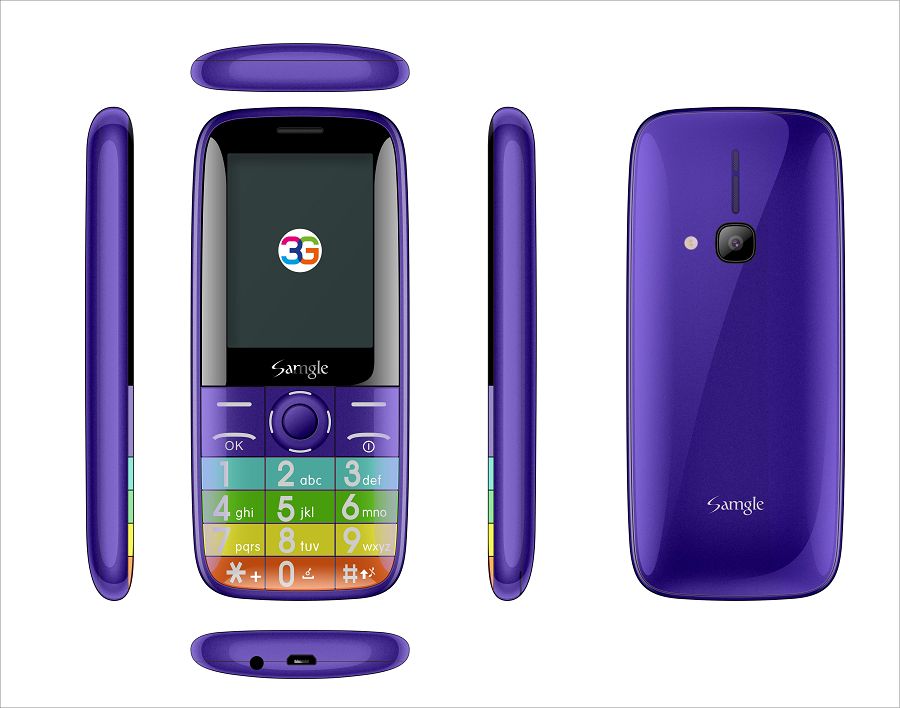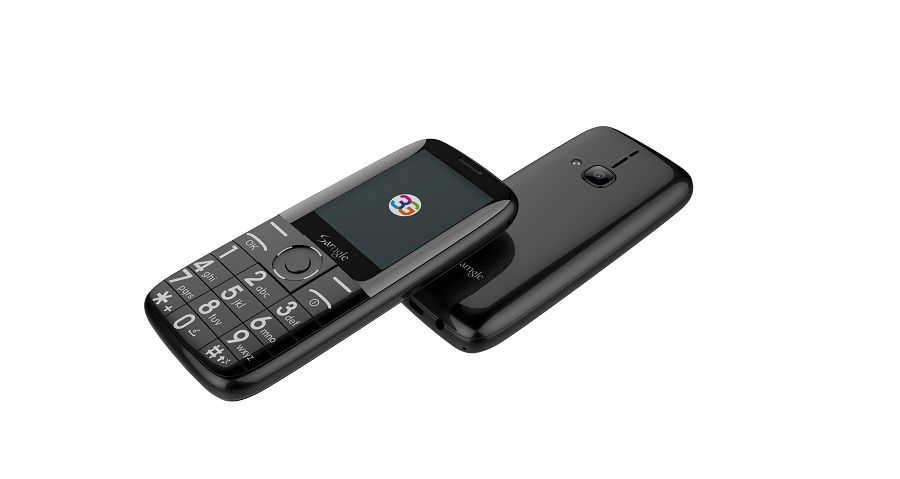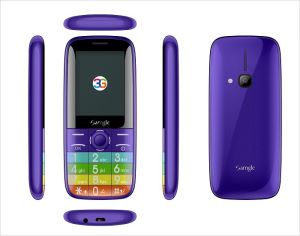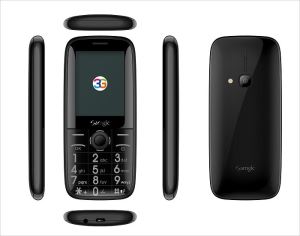




3G WCDMA 2.4 Inch
-
Payment


-
Origin
China Mainland
-
Minimum Order
5
-
Packing
Pieces
- Contact Now Start Order
- Description
Product Detail
Samgle zoey 3G: We've reimagined the button. Now reimagine how you experience the world.
Display"2.4" inch curved window
Storage:128MB+64MB
Support micro SD (T-Flash):Max to 32GB
Camera:Rear SW 2.0M
Color:Black?Purple?Blue
Wireless & Networks
Band Details(EU):
GSM:B2/B3/B5/B8 (1900/1800/850/900)
WCDMA:B1/B8 (2100/900)
SIM Card Type: SIM + SIM + TF
Language:English, Espanol, Portuguese, Italian, German, French, Russian, Arabic,Poland, Dutch, Bahasa Melayu, Chinese, Hindi, Tamil, Thai, myanmar,
SIM:Dual sim dual standby, Dual SIM; SIM1 is 3G, SIM2 is 2G
Dimension and Weight
Product size: 5*126*14.3mm
Product weight:64.5g
Battery weight:32g
Package size:142*136*35mm
Package
1 x Phone
1 x Battery (1450 mAh)
1 x AC power charger adapter ( 100~240V / EU plug)
1 x English user manual
NOTE
*The actual size and weight of the phone may vary due to different specifications and assembly tolerance
*The above data were gathered in tests in a lab environment. To avoid phone damage or malfunctioning
please avoid using your phone under extreme conditions


















Q: Hi is this cell phone 2 sim cards and both are thet 4g 0r 3g
A: Dual SIM,SIM1 is 3G, SIM2 is 2G
3G:WCDMA 900/2100
2G:GSM 850/900/1800/1900
Q: what network will this work with in the USA and what will i need to make it work.
A: Please check with your local communication company if they suport this network frequency:
GSM networks: GSM 850 /900 /1800 / 1900MHz
WCDMA:900/2100,
Q: Will it work with AT&T 3G SIM in USA
A: Please check with your local communication company if they suport this network frequency:
Dual SIM,SIM1 is 3G, SIM2 is 2G
3G:WCDMA 900/2100
2G:GSM 850/900/1800/1900
Q: It does work in Malta, EU? Can this mobile be Branded ? If it works in Malta I want to put my Logo on them and order a big quantity.
A: This phone will only work with GSM networks: GSM 850 /900 /1800 / 1900MHz, 3G:WCDMA 900/2100
Please check with your carrier / provider before purchasing this item.
Please note that it can be Branded
Q: Is this model really installed in Czech?Language Russian?
A: Thanks for your inquiry.
English, Espanol, Portuguese, Italian, German, French, Russian, Arabic, Poland, Dutch, Bahasa Melayu, Chinese, Hindi, Tamil, Thai, myanmar,
Please note that it can be set to Russian
Q: hello, does this phone have the feature to record incoming calls?thank you
A: Thanks for your inquiry.
Please note that it has the call records
Q: Does this phone have GPS, Thank you
A: Sorry that this phone doesn't have GPS,
What is the UMTS Network?
UMTS stands for the Universal Mobile Telecommunication System. The UMTS network is a wireless 3G (third generation) network that provides high bandwidth voice and data service to users of mobile devices. 3G is a category of digital cellular radio systems developed under the standard IMT-2000 (International Mobile Telecommunications-2000).
The 3G systems were created with the intention of allowing users to have global mobility with services including Internet, data, messaging, paging, and telephony. The idea was to provide consistent service to roaming mobile customers anywhere in the world. A combination of terrestrial-based wireless services and satellite transmissions were designed to provide this availability.
The UMTS network is also called 3GSM (Global System for Mobile communications) because it evolved from that system. The air interface for the UMTS network is based on WCDMA (Wideband Code Division Multiple Access) and includes the HSPA (High Speed Packet Access) specification. The Internet protocol was based on GPRS (General-Packet Radio Service), which evolved into EDGE (Enhanced Data rates for Global Evolution, a.k.a. GSM Evolution), both of which were considered 2.5G standards.
There are several ways in which the UMTS network differs from prior systems. One way is that previously, cellular systems were mainly circuit-switched, while UMTS is packet-switched. It also has higher bandwidth than previous systems.
The services provided by UMTS have three different Quality of Service (QoS) target data rates. These are 144 kbps (kilobytes per second) for satellite use and outdoor rural use; 384 kbps for use in outdoors in urban environments; and 2048 kbps for indoor use and outdoor use that is low-range. There are four specified classes of serve. The conversational class includes voice services, video gaming, and video telephony. The streaming class includes multimedia, webcasting, and video on demand. The interactive class includes web browsing, accessing databases, and network gaming, while the background class includes email, downloading, and SMS (Short Message Service) messaging.
LTE (Long Term Evolution) has developed out of UMTS. LTE and WiMAX (Worldwide Interoperability for Microwave ACceSs) are the two developments of 4G wireless networks, as of 2010. Whereas LTE started with the IMT-2000 standard that underpins the UMTS network and is sometimes referred to as UMTS LTE, while WiMAX draws on other standards.
What Is a Multimedia Phone?
A multimedia phone is a cell phone that has at least some capacity to access the Internet, take photographs, and transmit data in addition to making simple voice calls. In common parlance, the phrase “multimedia phone” is often interchanged with "smartphone." From a technological perspective, however, there is usually some difference between a multimedia phone and a smartphone. Most of this owes to network speed, download and upload capabilities, and bandwidth usage. In many respects a multimedia phone is something of a middle-of-the-road phone: it can do more than a straight features phone, but not as much as a smartphone.
Cell phone service providers typically sell phones and attendant service plans in three categories. A straight features phone or camera phone is usually the most basic model available. This kind of phone can place and answer calls, send and receive text or SMS messages, and snap basic photos in most cases. A multimedia phone is usually the next step up. Phones in the multimedia category are usually able to surf the Internet and access a variety of multimedia content, often including the ability to store and play music.
A phone that is marketed as a "video phone" or "Internet phone" is in all likelihood a multimedia phone. Multimedia phones usually have an array of different media-oriented capabilities. Still, they are designed to be a phone above all else.
At the far end of the spectrum exist smartphones. A smartphone is a phone that acts in many respects like a computer. It can upload and download files from the Internet, and can act as a global positioning system (GPS); it can take videos and then send them on to contacts, or upload them to social networking pages. Video chatting and real-time messaging is usually possible, and apps are constantly being designed to improve phone features and enhance communication capabilities.
It could be argued that a smartphone is, in practice, the most multimedia-ready of all the phones on the market. Nevertheless, the label "multimedia" on a phone usually indicates some lesser degree of technological advancement. The crux of what makes a phone a multimedia phone is usually its operating system, which is typically very basic. Multimedia phones can get on the Internet, but usually at slower speeds; files can be accessed, but not always downloaded. Similarly, content can be viewed, but not usually rapidly shared.
Multimedia phones are good options for people who want the flexibility of mobile Internet access and some enhanced communication, but either do not have the need for — or do not wish to pay for — more advanced services. Most of the time, multimedia plans are more competitively priced than smartphone data plans. They come with less, but they accordingly also cost less.
What is a Calling Card?
A calling card is a prepaid "credit card" that can be used to redeem telephone or cellular phone minutes. By purchasing a calling card, you purchase minutes up front. Various phone carriers and third parties manufacture calling cards, and there are two basic kinds: those used with pay as you go cellular plans, and those used for long distance landline phones.
A pay as you go plan does not require monthly fees or billing like a standard cell phone plan. Instead, the user purchases a calling card and registers its serial number with the carrier. The carrier adds minute-credits to the phone according to the value of the calling card. Once the credited minutes from the calling card have been exhausted, a new calling card must be purchased and registered to continue to use the phone. This plan is popular with teenagers who don't yet have credit cards and with those who use their cell phones very little.
Another type of prepaid calling card is the long distance calling card for landlines. In this case, the purchaser calls an 800 number to register the card, set up an account, and obtain a personal identification number (PIN). Typically, the access number and PIN must be entered prior to dialing a phone number. The carrier electronically tracks how much credit is left on the calling card and puts calls through as long as credit remains. This type of calling card is handy for international travel or business trips. Some cards can be "recharged" by adding more money to the account.
Parents often purchase prepaid calling cards for college students away from home. Kids at camp can also use a prepaid calling card, and it can be a good way to budget long-distance spending habits.
There are also calling cards that are not prepaid, but accrue monthly charges based on calls made. This type of calling card lacks spending controls, but might be preferable for businesses.
Calling cards purchased online may consist only of an access number and PIN, rather than an actual plastic card. Note that online or off, carriers sometimes go out of business, and clients with pre-purchased minutes can lose leftover credit. If buying a calling card, it may be best to stick with a reputable company or look for a service contract that ensures returned credit under these circumstances.
Calling cards come in many denominations, from 5 US Dollars (USD) to 50 USD or more. If someone you know has a pay as you go plan, a calling card from their cellular carrier can be a great gift. Have a relative or friend who lives far away? A standard prepaid calling card is a nice way to say, "I'm here anytime." Calling cards are available at grocery stores, discount marts, cellular and electronics stores, and many other outlets.
What is a SIM Copier?
A Subscriber Identity Module card (SIM) copier is an electronic device that reads information stored on your cell phone SIM card. The information may either be stored on the device for future use, or used immediately to transfer phonebook contacts and saved data from one SIM to another. Some SIM copiers work with only 2G cards, while others work with both 2G and 3G.
A SIM card may hold all personal contact information stored on a cell phone. When a new phone is purchased, a SIM copier can be used to transfer all contact information from the old SIM to the new one. As a backup tool, a SIM copier may be able to store this information in case of accidental damage or loss of the SIM or phone.
While some SIM copiers store data on the machine, others transfer information to a personal computer (PC). A PC SIM copier may require a USB connection to the computer. The copier acts as a portal through which information is passed from SIM card to software installed on the PC.
If information must be copied to a new SIM, the USB is reinserted with a new SIM in place, and contacts are moved from PC to SIM. If information is stored directly on the copying device, any damage to that device may cause loss of information. When information is moved to the PC, it can often be edited before copying to the new card.
In some cases, a SIM copier can be used to create a SIM clone. Clones are exact copies of the original SIM that can be used in a separate phone. In order to copy the encrypted information from one SIM to another, a SIM copier and clone software may be needed. Clone software attempts to read International Mobile Subscriber Identifier (IMSI) and Authentication Key (Ki) from the SIM card. Once read, the information can be used to mold a second SIM to mirror the first.
SIM copiers vary in size. The smallest are often the size of a keychain, — just large enough to fit the card into a reader. Larger, handheld models are also available. SIM copiers are frequently used by cell phone providers when customers change phones. They are used to move old data from one SIM to another, as a convenience to the customer. Businesses may also use SIM copiers to store contact information from a business phone that may be important.
- 3310 Cheap 2.4-inch 3G Feature Phones 5 Pieces / (Min. Order)
- 3310 Dual SIM Big Fonts 3G Cell Phone 5 Pieces / (Min. Order)
- 3310X 3G Low Cost Senior Phone 5 Pieces / (Min. Order)
- 3310X 3G Senior Phone 5 Pieces / (Min. Order)
- 3310X 3G Feature Phone 5 Pieces / (Min. Order)
- 3310X 3G Bar Senior Phone 5 Pieces / (Min. Order)
- 3G WCDMA Dual SIM 5 Pieces / (Min. Order)
- Zoey 2.4-inch Bar/Big Button 5 Pieces / (Min. Order)














 Favorites
Favorites
